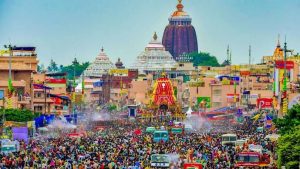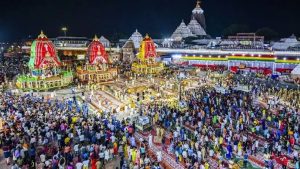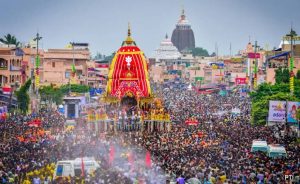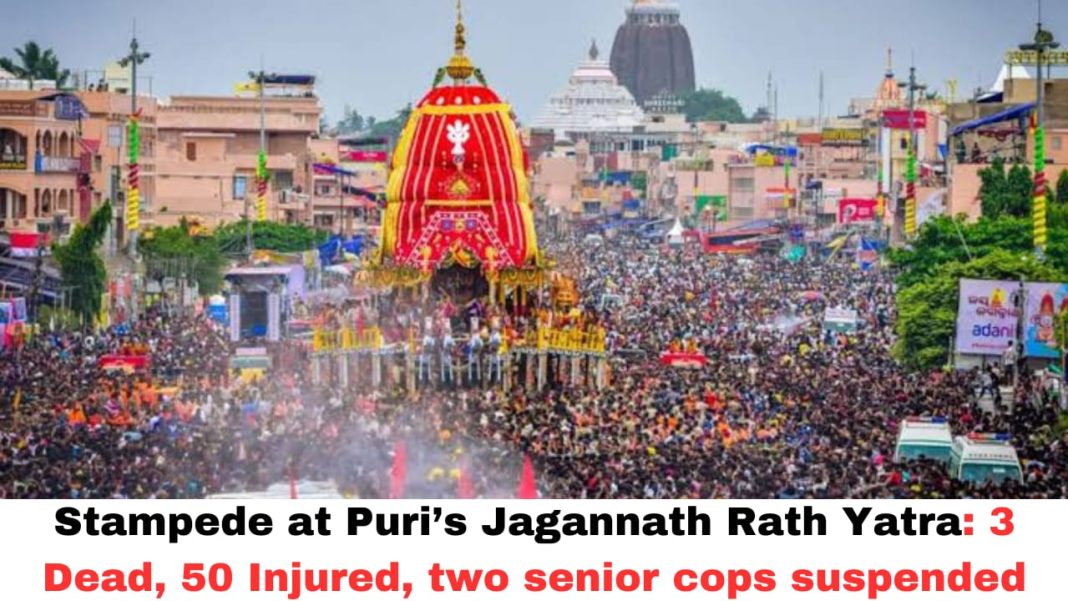Digital News Guru Odisha Desk:
Tragedy at Puri: Stampede During Jagannath Rath Yatra Claims Lives and Sparks Outrage
On June 29, 2025, early in the morning hours, tragedy struck Puri’s centuries-old Jagannath Rath Yatra—one of the world’s most revered religious processions—when a stampede near the Gundicha Temple led to at least three fatalities and over 50 injuries. This incident has once again cast a harsh spotlight on crowd safety at mass gatherings in India.
The Sequence of Events
The stampede occurred during the “pahada bhanga” ritual, traditionally held in the early morning when the deities are removed from their chariots for rest. Around 3:30–4:30 AM, as devotees surged for a glimpse of Lord Jagannath, two ritual trucks—bringing sacred wood—entered the already overcrowded Saradhabali area, triggering panic and chaos. Many worshippers fainted or experienced breathlessness as people trampled over each other.

The deceased were identified as Premakant Mohanty, aged ~78, Basanti Sahu (36), and Pravati Das (45), all killed either on the spot or from their injuries later in hospital. Six individuals required hospitalization, with over fifty treated on site.
A Festival with a Massive Following
The Rath Yatra is an annual spectacle drawing hundreds of thousands—even up to a million—pilgrims to Puri. The three chariots of Jagannath, Balabhadra, and Subhadra traverse the 3 km Bada Danda to Gundicha Temple, where the deities remain for seven days. This year’s festival, held from June 27–July 5, saw especially heavy turnout—1.5 times higher than usual—fueled by favorable weather, exacerbating crowd pressures throughout the procession
Administrative Response: Discipline and Compensation
Pledged a Rs 25 lakh ex-gratia payment to each victim’s family. Within hours, Puri’s Deputy Commissioner of Police (DCP) Bishnu Charan Pati and Police Commandant Ajay Padhi were suspended, while the Collector Siddharth Shankar Swain and Superintendent of Police Binit/Vinit Agarwal were transferred. Odisha’s Director General of Police Y. B. Khurania personally reached Puri to oversee the inquiry.
Additionally, the state government has initiated an administrative inquiry to examine security lapses and prevent future catastrophes.
Political Fallout: Criticism and Demands for Accountability
The calamity reignited political tensions over festival safety:
- Naveen Patnaik, former Odisha Chief Minister, sharply criticized the current government’s “blatant callousness” and “glaring incompetence,” asserting there was “no government machinery present” during the crisis.
- Congress President Mallikarjun Kharge condemned the incident as a result of “negligence and mismanagement,” stating such lapses are “inexcusable” and called for a thorough inquiry.
- Rahul Gandhi, Leader of Opposition in Lok Sabha, echoed these concerns, emphasizing the stark need for proper crowd control at major religious events.
- Government Law Minister Prithiviraj Harichandan and CM Majhi emphasized immediate investigation and swift punitive action.

Underlying Causes: What Went Wrong
- Overwhelming Crowd Density
With devotee numbers roughly 1.5x greater than usual and ritual timings shifted to early morning, crowd control became unmanageable.
- Ritual Vehicles in Restricted Zones
Two trucks carrying ceremonial wood entered an already congested area, triggering a mass surge.
- VIP Routes Without Safeguards
A separate entry for VIPs unintentionally funneled devotees into narrow choke points—setting off the panic .
- Lack of Emergency Infrastructure
No visible medical or fire personnel were on-site when chaos erupted. Initial relief was provided by local volunteers.
Health Impacts Beyond the Stampede
Even before dawn, severe crowding took a toll. On June 28, roughly 750 devotees were hospitalized for heat exhaustion and crowd-induced conditions. Over 230 were treated at Puri’s Infectious Disease Hospital and 520 at the District HQ Hospital; 12 required ICU care, with at least one critical case referred to SCB Medical College in Cuttack.
Lessons and Future Reforms
This calamity adds to a growing trend of crowd disasters in India—such as the 2025 New Delhi railway station crush earlier this year—that demand rigorous crowd-safety planning
Recommendations for future Rath Yatras include:
- Strict crowd caps and entry regulations,
- Adequate deployment of trained crowd control personnel,
- Physical barriers and segregated lanes for devotees and VIPs,
- Off-limit zones for vehicles during prayers,
- Emergency medical and fire units stationed at key areas,
- Live crowd monitoring, and transparent coordination between temple authorities and security forces.

Looking Ahead: Accountability and Oversight
- Ongoing inquiries by Odisha’s government and law enforcement aim to identify failures and recommend corrective measures.
- Suspended officers face possible departmental and legal action, while the transferred Collector and SP are under review.
- Broader judicial involvement or parliamentary scrutiny is expected to ensure systemic changes.
If these measures are ignored, the impending Bahuda Yatra—when the deities return—will once again become a test of whether meaningful reforms were implemented.
You May Also Read: Fastest Monsoon Since 2020: India’s Rain Blanket Arrives 9 Days Ahead








